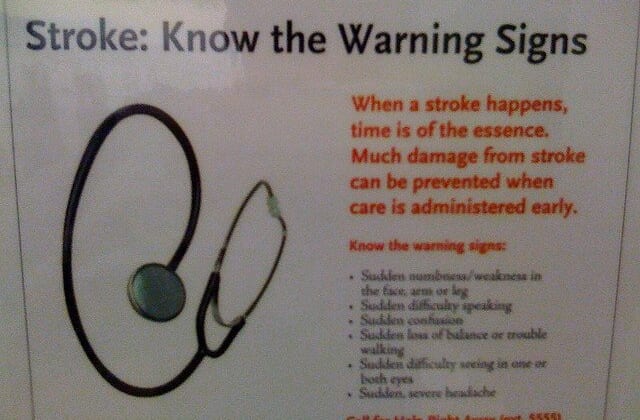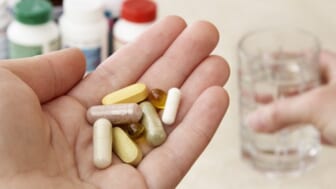
Your heart is not the only potential victim of cardiovascular disease. Your brain can be to, a Stroke is a type of cardiovascular disease that affects the arteries leading to and within the brain.
A stroke occurs when the blood vessels that carry the oxygenated blood and nutrients to the brain are either blocked by a clot or break. This prevents the brain from getting the oxygen and nutrients it needs, and within minutes to a few hours brain cells begin to die.
Every 45 seconds someone in the United States has a stroke, and every three minutes someone dies of stroke. That’s about seven hundred thousand strokes a year, of which about 160,000 result in fatalities. I can’t stress enough how important it is to learn how to recognize the symptoms of stroke because it can save your life or the life of someone you know.
The most characteristic symptom is a sudden numbness, weakness, or paralysis of the face, arm, or leg, usually on one side of the body. Other symptoms include loss of speech or trouble talking, blurry vision, double vision, decreased vision, dizziness, loss of balance and coordination, an out-of-the-blue bolt of pain, headache, vomiting, or altered consciousness and disorientation or memory loss. Usually these symptoms strike suddenly and without warning. It is important to recognize the signs and symptoms of stroke because every minute counts when it comes to treating one. The longer a stroke goes untreated, the greater the damage and potential disability. So if you have any of the signs and symptoms of stroke, it is important to get help immediately. Eighty percent of strokes are ischemic, which means they are caused by an obstruction from a blood clot or particle of cholesterol plaque that reduces the blood flow to the brain. The brain cells die within minutes of this happening.
There are two types of ischemic stroke. Thrombotic strokes are caused by clots that originate in the arteries that supply the brain, like the neck arteries, or the arteries within the head itself. Embolic strokes originate from blood clots that form away from the heart but are swept up through the bloodstream and into the narrow arteries of the brain.
The other 20 percent of strokes are hemorrhagic; they occur when a blood vessel in the brain leaks or breaks. The most common risk factor for hemorrhagic stroke is uncontrolled hypertension, though it can also be caused by an anatomical weakness of the blood vessel itself, that is, an aneurysm, or by an abnormal connection of the arteries and veins in the brain.
Ischemic Strokes
People who have transitory ischemic attacks—a temporary halt to the flow of blood to the brain—have a ninefold increase of developing a full-blown stroke.
At higher risk are those who have a family history of stroke, are older (the older we get, the greater the chance of stroke), and are African American, partly due to the high prevalence of high blood pressure and diabetes among the black community.
Other factors include hypertension, high cholesterol, cigarette smoking, diabetes, obesity, cardiovascular disease, and high homocysteine levels. Homocysteine is an amino acid in the blood, and people with elevated homocysteine levels have a higher risk of stroke.
Women taking birth control pills or hormone replacement therapy may also be at higher risk for stroke. The good news is that there actually are some things you can do to avoid being a victim of stroke.
Even though you cannot do anything about your race, your sex, your family history, or your age, since cardiovascular disease and stroke go hand in hand, you certainly can look at your risk factors for heart disease and hypertension and focus on early screening. Get your blood pressure checked; learn what your body mass index is; and check your cholesterol and glucose levels every two to five years.
Exercise, manage your stress, limit your alcohol consumption, don’t smoke, and stay away from foods with saturated fats.
Take a vitamin B complex, like B6, B12, and folic acid, which are essential in helping to reduce the levels of homocysteines in the body.
Don’t take illicit drugs, like cocaine, which may trigger a stroke. People with risk factors for stroke should consider a brain-healthy diet that includes several servings daily of fruit and vegetables with nutrients rich in potassium, folate, and antioxidants.
Eat foods high in soluble fiber, like oatmeal, to help reduce cholesterol, as well as foods rich in calcium and soy that help reduce your bad cholesterol and raise your good cholesterol. Foods rich in omega-3 fatty acids, which include, of course, plant oils, salmon, and other cold-water fish like tuna, are also good weapons in the battle against stroke.
Stroke Treatments
When it comes to the treatment of strokes, some hospitals have actually established special stroke emergency rooms that are manned by a multidisciplinary team well versed in their diagnosis and treatment.
Whoever the doctor is, however, he or she must first determine the type of stroke and its location before treating it. A wide variety of diagnostic tests are available to the doctor, and they all fall into one of three categories: imaging tests, which provide a better-than–X-ray picture of the brain; electrical tests, which record the impulses in the brain; and blood flow tests, which show any problem that may be causing changes in blood flow to the brain.
Essentially, all emergency room doctors will attempt to improve and restore blood flow to the brain of a stroke victim. One way to do that is by injecting a clot-bursting drug, or thrombolytic, that helps dissolve the clot.
Other techniques include performing a surgical procedure such as carotid endarterectomy, in which the surgeon opens the carotid arteries and removes the plaque from them, or angioplasty, in which a balloon-tipped catheter dilates the arteries to improve the blood flow.
Once a stroke has been diagnosed and treated, most individuals end up taking preventive medicines to minimize the chances of recurrence. Some may receive antiplatelet drugs to make platelet cells in the blood less sticky and less likely to form a clot, or anticoagulants, which again prevent the blood from clotting.
In cases of hemorrhagic stroke, where a blood vessel has ruptured, surgical intervention is needed to minimize further bleeding by clipping, cauterizing, or removing the clot and any vessel that is actively bleeding.
Stroke survivors must cope with a life-changing experience. They are often significantly disabled and, as a result, need a strong support system. Usually, the support system is a team of rehabilitation doctors, which might include a psychiatrist, a dietitian, an occupational therapist, a physical therapist, a speech therapist, and social workers.
A stroke victim has to deal with impaired movement, which has implications for walking, balancing, speaking, swallowing, and breathing; bladder and bowel dysfunction; and diminished sex drive—as well as all the emotional issues that result from those problems.
A stroke victim’s family is also profoundly affected because they now have to take part in caring for the individual. Stroke can change your life completely, so learn to recognize it and treat it urgently to minimize the terrible disabilities it can inflict on its victims.
The Other Victims Of A Stroke
The obvious result from a major stroke is a devastating disability—such as speech impairment, weak hand and leg movement, and depression. But a stroke can also have an indirect effect on the health of the victim’s family and friends.
Imagine a very strong and vibrant man who has never been sick, who has been a good husband and provider, who has been a great father. His family, and especially his wife of 45 years, marveled at his strength. He was healthy and looking forward to a peaceful and blessed retirement. Then one day he suffered a major stroke, which left him unable to speak and walk.
For the family, the confusion and shock were intense. How could this have happened? This is not a fictional story. It happened in my family. When I first met my future father-in-law, I never imagined that one day his life would end up in such a way.
However, this same scenario is played out over and over again in many families across the United States and around the world. All of a sudden, the responsibilities that were the stroke victims are now delegated to other members of the family, and in some cases the majority of the responsibilities falls on the spouse.
From everyday things like shopping or paying bills to new responsibilities like making daily trips to the rehabilitation center; feeding, bathing, and keeping up with all the medications; and becoming a motivational guru.
All of this can have a tremendous impact on the caregiver’s health. Suddenly, what was once an ordinary life becomes an extraordinary one burdened by the pressure and eased by the love for the ailing family member.
We doctors sometimes forget about the families, and that’s a big mistake. When dealing with stroke survivors, focusing on the family as a whole is always important. We must listen, support the changes that are needed, and monitor stress and the effect that it has on the people taking care of stroke survivors.
Family members take care of one another; they become the pillars of health care in the home and improve the outcome that any therapy in the hospital could bring. I remember the look of my mother-in-law as she dealt with her husband’s disabilities, a look of love, duty, and compassion. But we must always make sure that, as we take care of others, we take care of ourselves.
If you don’t take care of your own health, you may very well end up being unable to take care of the person you love. So stay healthy. They don’t say “in sickness and in health” for nothing.

